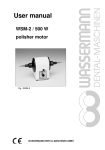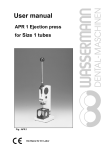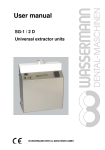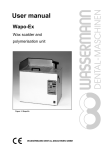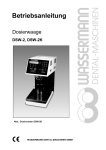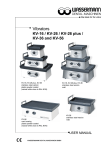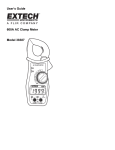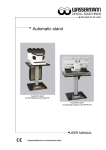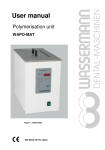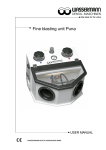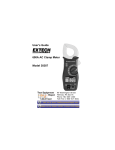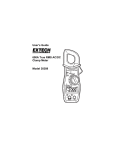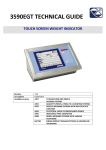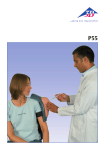Download User`s Manual - Wassermann Dental
Transcript
User’s Manual DSW-2, DSW-2/4K dosing scales DSW-2/4K dosing center WASSERMANN DENTAL-MASCHINEN GMBH -1- Dear customer, Thank you for choosing a model from the Wassermann product range. Wassermann dental equipment represents the highest quality and the latest technology. To get the best performance from your equipment and to guarantee years of troublefree use, please read this user’s manual carefully before starting the unit, and operate it according to instructions. Keep your user’s manual in a safe place so you can refer to it as needed. Company address: Wassermann Dental-Maschinen GmbH Rudorffweg 15-17 D-21031 Hamburg Germany Tel.: +49 (0)40/ 730 926-0 Fax.: +49 (0)40/ 7303724 email: [email protected] URL: http:// www.wassermann-dental.com -2- Contents CONTENTS.......................................................................................................................2 1 1.1 1.2 1.3 2 2.1 2.2 2.3 FEATURES................................................................................................................3 PRODUCT DESCRIPTION ...........................................................................................3 PRODUCT DESIGN ....................................................................................................3 MATHEMATICAL BASIS FOR CONTROL AND PROGRAMMING ..........................................4 FOR YOUR SAFETY .................................................................................................4 READ THE USER’S MANUAL .......................................................................................4 SAFETY INSTRUCTIONS .............................................................................................5 RESPONSIBILITY FOR OPERATION AND DAMAGE ..........................................................5 3 APPLICATIONS ........................................................................................................6 4 BEFORE YOU START ..............................................................................................6 4.1 4.2 UNPACKING / TRANSPORT ........................................................................................6 SET-UP / STORAGE ..................................................................................................6 5 START-UP.................................................................................................................8 6 OPERATION..............................................................................................................8 6.1 6.2 6.3 6.4 6.5 6.6 6.7 PROGRAMING ..........................................................................................................9 CALCULATING DOSING QUANTITIES PER PUMP ..........................................................11 RINSING / FILLING / EMPTYING .................................................................................14 PRINTING MEASURING RESULTS ..............................................................................16 DOSING .................................................................................................................18 USING COOLING .....................................................................................................19 TIPS AND TRICKS....................................................................................................20 7 TROUBLESHOOTING.............................................................................................20 8 MAINTENANCE ......................................................................................................21 8.1 8.2 8.3 8.4 8.5 8.6 9 CLEANING .............................................................................................................21 SERVICING ............................................................................................................22 WARRANTY............................................................................................................22 SPARE PARTS AND ACCESSORIES............................................................................22 REPAIRS................................................................................................................23 REPAIRING THE PUMP .............................................................................................23 TECHNICAL SPECIFICATIONS..............................................................................25 9.1 9.2 9.3 9.4 WEIGHING SYSTEM: ..........................................................................................25 DSW-2 .................................................................................................................25 DSW-2K ...............................................................................................................26 COOLING SYSTEM ..................................................................................................26 10 EG CONFORMITY CERTIFICATE.......................................................................27 -3- 1 Features 1.1 Product description Electronic scales with control system of 1 to 6 liquid pumps. Depending on whether plaster or embedding powder is being weighed on the scales, this unit can, at the press of a button, accurately reproduce up to 30 previously defined quantities. This feature derives from the fact that up to 6 liquids can be dosed in sequence with a very high level of accuracy. The DSW-2/4K dosing center is especially suitable for this purpose. This patented product also allows you to cool liquids to temperatures recommended by the embedding-mixture manufacture. The unit delivers the same degree of precision over the long term, yet pays for itself very quickly. 1.2 Product design The DSW-2 dosing scales contains the following components: − Scales − Controller − Dosing housing with 1 to 6 pumps (cooling unit), depending on configuration. − Rubber plugs to seal hose ends Options : Printer, interface cable with transformer and paper roll The DSW-2 or DSW-2/4K has a separate connector for the printer or computer. Pumps 1 to 6 (A to F) are located in a housing and are interchangeable. -4- 1.3 Mathematical basis for control and programming Dosing control is based on the following formula: Gges = GY + MX1 * γ1 +MX2 * γ2 + MX3 * γ3 Equation 1 where, Gges = Total quantity [in g] of all weighed amounts of different materials GY = Weight component of, eg, plaster powder or similar material MX1... MX3 = Quantity [in ml/100g] of liquid to be dosed from any selected pump γ1 .... γ3 = Density [in g/cm3 or g/ml] of particular material/liquid 2 For your safety 2.1 Read the user’s manual The operation and handling of this product require close knowledge and observance of these operating instructions. The product is intended only for the purpose described. These operating instructions contain the following very important symbols: Warning ! This symbol indicates risks and dangers. Ignoring this warning can ! i lead to life-threatening situations. You must observe these warnings. Information ! This symbol indicates important features or facts. -5- 2.2 Safety instructions When dosing, use only liquids recommended for mixing ! embedding materials and plasters for dental applications. Do not use petrol, oil or acids, solvents or flammable substances. Concentrated embedding materials can damage your health. Read the manufacturer’s data sheets carefully. This equipment is designed for 115V / 60Hz. Check that it is always connected to the correct mains voltage. Always disconnect the power cord before undertaking maintenance or cleaning work. Never blow compressed air through the hoses. 2.3 Responsibility for operation and damage The owner or operator is always responsible for the equipment if it is incorrectly serviced, maintained or altered by persons not associated with an approved workshop or if it is operated in a manner which is not in accordance with its intended application. The equipment must be maintained and operated in accordance with these operating instructions. Wassermann Dental-Maschinen GmbH is not responsible for damage caused by non-observance of these instructions. The warranty and responsibility conditions of Wassermann Dental-Maschinen GmbH for sales and supply are not extended by the present instructions. i Ensure that the user’s manual is on hand at all times and has been read and understood. -6- 3 Applications The DSW-2 dosing scales allow you to mix embedding materials and plasters with consistent accuracy. If you have a printer, you can document your dosing procedures or program parameters. 4 Before you start 4.1 Unpacking / Transport − Remove the packing materials and place the unit on a stable, level base. Check that any accessories are present (see 8.4). − When transporting the unit, use suitable packing materials in order to avoid damage in transit. 4.2 Set-up / Storage − Choose a location for the scales and container where they are protected from direct sunlight or other sources of warmth such as heaters. − Set the unit up on a level, horizontal surface. − Make sure you have adequate space in your work area (take dimensions into account). Do not set the unit up out of doors! − If the unit is to be stored for an extended period, protect it from moisture and dusty. − Follow the procedure below to remove the securing piece from the scales before you start work: -7- 1. Remove the stainless steel pan from the scales. 2. Remove the safety packing between the pan and the housing. 3. Replace the pan. 4. If you have a printer, connect it to the controller. Connect the printer to the network and insert the plug in the socket. i All plugs can only be inserted in one orientation. The DSW-2 dosing scales must be at room temperature before you use it. i Screw in all connectors. − Select the appropriate quantities of the individual liquids. If using containers without a 6.5mm hole, unscrew the cover. Use a tool such as a drill press and a conventional drill bit to make a 6.5mm hole in the center of the container lid. − If the density of the media is known (if not, see 6.2.1), fill the containers with the relevant liquids, then seal the containers. Mark each container and its lid with the letter of the dosing pump. The sticker (Fig. 2) on the rear or top of the housing indicates which hose belongs to which pump. F E D C B A Fig. 1: Pump outlets i When removing or replacing a lid, hold the lid firmly and turn the container to avoid twisting the hose. − The hoses are now filled by flushing (see 6.3). Make sure there are no air bubbles in the dosing hose. − If a pump has been loaded with embedding material but you do not want to dose immediately, seal the hose end with the rubber plug provided. -8- 5 Start-up Make sure that the safety packing has been removed before you ! start the unit. − Connect the dosing system to the mains. − The scales should be level, clean and free of any unwanted loads. − When you turn on the power, autotest characters ( C1 to C6) appear on the display, followed by the character or number of the program, then 0 to indicate the scales have been tared. − You can now weigh, dose, rinse or program. i The scales must always be horizontal. 6 Operation i All recommendations for using the equipment, whether verbal, written or in the form of practical examples, are based on our own experience and tests and can only be considered as guidelines. -9- 6.1 Programing 1. Turn on the power. The READY light comes on. 2. Press P. Pr nr appears on the display and the READY light goes out. 3. Use the numeric keypad to enter the program number. If you choose 0 or a number greater than 30 and press ENTER, the characters Err-P appear on the display, followed by Pr nr. 4. Press ENTER. Set P appears on the display. 5. Press A, B, C, D, E or F to select the pump for the appropriate liquid. 6. On model DSW-2, make sure that only one pump is installed (A) and that on model DSW-2k, pumps A, B, C and D are active. 7. P-A or the letter of the relevant pump appear on the display, with an o on the left to indicate the "programming option". 8. The program stores the identifier of the first pump to be switched on, the sequence of pumps to be activated, and the quantity assigned to each pump for dosing. 9. You then use the numeric keypad to enter the quantity of liquid (in ml/100g powder) to be weighed. 10. That value appears immediately on the display. 11. Press ENTER. Pr-A or the identifier of another pump (depending on the key pressed) appears on the display. 12. If you are not entering a liquid density for the selected pump, press ENTER again. A standard value (γ = 1) is assumed. 13. If the density of the liquid is to be specified, that value should be entered using the numeric keypad. The value entered appears on the display. 14. Press ENTER. 15. SET P appears again on the display. 16. Repeat points 4, 5, 6, 7, 8 for the following pump(s). 17. End programming by pressing ENTER. All ratios for mixing components and the order in which the pumps are to be activated remain stored in memory until new data are entered under that program number. 18. The o disappears and the READY light comes on. You can now weigh, dose, program or rinse. - 10 - 6.1.1 Correcting incorrect input − You can press CLR at any time durifng programming to change incorrect data (eg, pump number or density) in the current program. − If CLR is pressed again, the program is stopped. − When you press CLR, the letters CLR appear on the display, and lights READY and END go out. You now press ENTER to continue working. 6.1.2 Printing program parameters i Make sure that the printer is correctly installed and is switched on. − Press P to print program parameters. Pr nr appears on the display and the READY light goes out. − Use the numeric keypad to select (specify) the program number, then press ENTER. SET P appears on the display. − Press F1. PRINT appears on the display, and the parameters and pumpactivation sequence are printed out. Example of a printout of a program using two pumps: PROGRAMM-NR. / PROGRAM-NO.: X ANTEIL/ SHARE LIQUID 1 : 40 (ml/100g) LIQUID 1 : 1.22000 (g/cm3) ANTEIL/ SHARE LIQUID 2 : 5 (ml/100g) LIQUID 2 : 1.00000 (g/cm3) PUMPEN /PUMPS : A E Fig. 2: Printout of program parameters - 11 - 6.2 Calculating dosing quantities per pump Generally speaking, all dosing quantity data [ml] relate to 100g powder. Thus, the dosing quantity [in ml] and the density [in g/cm3 or g/ml] should be known for each liquid. 6.2.1 Determining the density of concentrates If the manufacturer does not indicate the density of the concentrate, you can determine it yourself quite easily. To do so, place a large calibrated beaker on the scales and press TARE. A 0 will appear on the display. Fill the beaker to the 1000ml mark with concentrate. Carefully note the weight. Then, simply divide the value shown by 1000 to get the density in g/cm3 or g/ml. If the volume of concentrate is less than 1000ml, divide the weight of the concentrate shown on the scales by the volume of concentrate to obtain the density. If you do not have a large beaker, carry out several (say, 5) measurements with a smaller beaker, then calculate the average value. 6.2.2 Example of calculating embedding materials Manufacturers of embedding materials (powders) specify concentrate quantities in Xml to Yg, which generally translates to Xml liquid to 100g powder. This relies on the fact that embedding materials are sold mostly in small bags (eg, 100g). You will find that this is much more expensive than buying a 5kg container of the material. The bags of powder come with a measuring beaker for measuring the concentrate (1st liquid). The concentrate can also be diluted with distilled water. - 12 - Say a manufacturer of embedding material states: 30 ml total liquid per 100g powder yields enough mixture for 1-2 molds. Possible dilution of concentrate: 10%-50% depending on expansion. The percentage figure refers to the volume or quantity in ml of liquid. The laboratory technician has the task of mixing enough embedding material for 3 molds (models) and wants to dilute the concentrate by 30%. He sees that there is no program so far for this dilution, but program number 30 has not been used. Now the technician calculates the quantity of concentrate (liquid 1) and the dilutant (liquid 2). It is important for all figures to relate to 100g powder. Concentration mix quantity: = quantity mixing liquid (ml/100g)* quantity concentrate = 30 [ml/100g] * 70/100 = 21 ml/100g Dilutant quantity: = quantity mixing liquid (ml/100g)* total dilutant of total liquid 30[ml/100g] * 30/100 = 9 ml/100g The scales are now programmed for this concentration. − He presses P. Pr nr appears on the display and the READY light goes out. He enters 30. − He presses ENTER. Set P appears on the display. − He presses A because that is the pump which will dispense the concentrate - 13 - from the powder manufacturer. P-A appears on the display, as well as o to indicate the programming option. − He then uses the numeric keypad to specify the quantity [in ml/100g] powder of the first liquid to be weighed (in this case the amount of concentrate). He enters 21. The value entered appears immediately on the display without indicating the unit. − He presses ENTER. P-A appears on the display. The technician knows the density of the concentrate from the manufacturer’s data (the density of the concentrate is generally provided by the manufacturer) or by weighing. Here, we assume the density is 1.2 g/cm3 = 1.2 g/ml. He enters 1.2. − He then presses ENTER. Set P appears on the display. − He presses D because the distilled water (dilutant) will be dispensed from that pump. − He then uses the numeric keypad to specify the quantity [in ml / 100g] of powder of the second liquid to be weighed (in this case the quantity of dilutant). So he enters 9. This value appears immediately on the display without indicating the unit. − He next presses ENTER. − Since the technician knows that the density of the water is approx. 1 g/cm3 = 1g/ml, he presses ENTER again or 1 because the density of 1 is stored as a standard value. − He presses ENTER again to end the program and store the data under program number 30. He now places two empty mixing beakers on the scales and presses TARE. Then, he takes a small spatula and transfers the approximate quantity of powder from the 5kg container to one of the beakers. The scales’ display reads 281g. This is too little powder, so he adds the rest. The display now reads 315g. - 14 - − The technician presses START. Pr nr appears on the display and the READY light goes out. − He uses the numeric keypad to specify the program number and enters 30. He then presses ENTER. Dosing starts and the READY light goes out. The scales calculate the weight of the dosing liquids. Of the concentrate powder weight (g) * concentration (ml/100g powder) * density (g/cm3 = g/ml) = 315g * 21ml/100g * 1.2g/cm^3 = 66.15 ml * 1.2 g/cm^3 = 66.15ml * 1.2 g/ml we must now add an extra = 79.38g. Of the dilutant (distilled water): 315g * 9ml/100g * 1.0g/ml we must now add an extra = 28.71g. The technician transfers the powder into the liquid and it’s finished. 6.3 Rinsing / filling / emptying If the pumps will remain unused for an extended period such as during holidays or when the medium is being changed, the entire dosing system will need to be cleaned. This is done by connecting a particular pump to the container filled with tap water or rinsing liquid. ! Never blow compressed air through the hoses. - 15 - 6.3.1 Filling / rinsing / emptying the pump system Squeeze off the tube end briefly during flushing to remove air bubbles from the system. There should be no more air bubbles present when the tube end is released. This procedure can be repeated as often as you like. − Screw the cover with the suction hose of the pump system to be filled or rinsed to the container holding the water/rinsing liquid. Remember to turn only the container to avoid twisting the hose. − Place a suitable container under the dosing hose. If necessary, set the hose to the correct height. − There are 4 switches at the rear of the pump housing on the DSW-2K. These are used to set the feed direction. − Press S. SET P appears on the display and the READY light goes out. − Press one of the six buttons assigned to the pumps (A, B, C, D, E or F). P-n appears on the display (n = the letter of the selected pump). − Press START. − Rinsing begins and the ∇ symbol corresponding to that pump lights up. − The rinsing process for cleaning the circuit should last for approx. 30seconds. − Once the rinsing is finished, the END light comes on. − You can continue by pressing ENTER. The READY light comes on and END goes out. If the liquid circuit does not fill completely, there are air bubbles at the hose opening. You will need to repeat the rinsing process. − Press CLR. The letters Clr appear on the display. The rinsing process can be interrupted immediately. You can continue after pressing ENTER. The READY light comes on. i Rinsing can be stopped at any time by pressing CLR. i Before changing a medium, check that the circuit has been rinsed clean. - 16 - i If you have changed the feed direction, remember that the switch i Make sure that there is as little air as possible in the feeder must be returned to the correct position for dosing. circuit. This is especially important with the DSW-2/4K as it can reduce pump performance. 6.4 Printing measuring results Printing is not possible: − If the printer is not plugged in – the symbol ---- appears after you press F1; − during dosing or programming – the symbol ---- appears after you press F1 Printing is possible only if: − lights END or READY are on or if neither is on. i If no dosing has occurred, the subsequent parameters or zero values are printed. You start printing by pressing F1. If all conditions have been met, PRINT appears on the display. During data transmission, the light near F1 comes on. - 17 - 6.4.1 Printout of measuring results The printout looks like this: -----------------------------------------------------------------------------------------------------------PRODUKT / PRODUCT: _____________________________ HERSTELLER / MANUFACTURER: _____________________________ PROGRAM-NR / PROGRAM-NO.: [ 1-30] ANTEIL / SHARE LIQUID 1:[prog value] (ml/100g) LIQUID 1:[prog value](g/cm3) ANTEIL / SHARE LIQUID 2:[prog value] (ml/100g) LIQUID 2:[prog value](g/cm3) ANTEIL / SHARE LIQUID 3:[prog value] (ml/100g) LIQUID 3:[prog value](g/cm3) MESSERGEBNISE / MEASURING RESULTS ----------------------------------------------------------------------------------------------------------PULVER / POWDER: ..................... [actual value] g LIQUID 1: LIQUID 2: LIQUID 3: [actual value] ml [actual value] ml [actual value] ml [actual value] g [actual value] g [actual value] g ( [nom. value] ml ) ( [nom. value] ml ) ( [nom. value] ml ) DATUM / DATE :__________UNTERSCHRIFT / SIGNATURE:_________________ ----------------------------------------------------------------------------------------------------------Fig. 3 : Printout of measuring results - 18 - 6.5 Dosing 1. The liquid amounts and densities are known. 2. Place two mixing beakers on the scales and press TARE. i If no 0 is displayed, press TARE again. 3. Transfer the desired amount of powder into a mixing beaker. 4. If the READY light does not come on, press ENTER. The READY light will come on. 5. Press START. Pr nr appears on the display and the READY light goes out. 6. Use the numeric keypad to enter the program number. If you enter 0 or a number greater then 30, Err-P then Pr nr appear on the display. 7. Press ENTER. Dosing starts and the READY light goes out. The program checks that the quantities do not exceed the maximum value. If the maximum value is exceeded, Err-H appears on the display and dosing is stopped. 8. The program also checks that the amount of powder is greater than 5g. If it is less, Err-L appears on the display and dosing does not start. Another check is carried out to make sure the maximum dosing portion does not exceed 1000% of the powder amount (Err-H message) and that the minimum dosing portion is greater than 2g (if not, message Err-L). 9. To interrupt the process, you press CLR, then ENTER to continue. 10. If no errors are detected, the symbol ∇ appears on the display to indicate which pump is working. 11. The pump (or pumps) automatically dose(s) the predetermined quantity of liquid. 12. When the next pump is switched on, the display shows the ∇ symbol of the pump which is working. When dosing finishes, the END light come on. 13. After ENTER is pressed, the dosing scales are ready to start again. The READY light comes on and END goes out (only to program level C2_08). - 19 - 6.5.1 Stopping the dosing process − The dosing process can be stopped immediately by pressing CLR. Clr appears on the display. You press ENTER to reset the unit. The READY light comes on. Dosing can be stopped at anytime by pressing CLR. i 6.6 Using cooling – Turn on the green main switch (on the side of the unit). – Select the temperature using the rocker switch at the side. – Temperatures 17°,19° and 21° Celsius are available. (The middle temperature (19°) is usually recommended.) – Wait for the green LED to flash. This can take up to 45 minutes, depending on the ambient temperature. The liquid will then have reached the tolerance range of the set temperature. – Green light means minimum permissible temperature reached. The cooling switches itself off automatically. An occasional change between a steady and a blinking green light on the display does not indicate a fault. – Red light means "Warning" – cooling is faulty. Switch off immediately. You are recommended to switch the cooling unit on in good time (timer) or to have it on continuously. Try working at a higher temperature – this often yields better results. - 20 - 6.7 Tips and tricks − If you are mixing large quantities, add material by hand during the dosing process. Take care, however, not to exceed the weight you want to weigh. Stop if you hear the pump laboring before the nominal weight is reached. − Remember that some embedding materials can only be worked for a short time at temperatures above 25°C. Locate the dosing scales and the liquid container in a cool place. 7 Troubleshooting Error/fault No weight shown on display likely cause Transport packing not removed possible solution Remove transport packing. Err-H displayed Maximum weight exceeded Remove powder from mixing beaker and repeat dosing process. Err-L displayed Under minimum weight or dosing quantity too small Add more powder to beaker and repeat dosing process. No response from keys P, END light is on, process is Press ENTER and start S and START finished or was stopped process again. Dirty hose Pinched hose Container empty Suction hose length in container too short Clean hose and/or remove contamination. Check hose line and liquid level in container. Pump works but feeds nothing or too little − − − − Pump does not respond Pump faulty Pump blocked Pump not plugged in Pump slipping Check pump or contact our Service Department. Unscrew unit at rear, demount pump head, roughen shaft surface (see 8.6). Wrong medium supplied − Wrong lid and/or container − Wrong material in container − Error in program Check container and program. If necessary, print out program parameters. - 21 - Error/fault likely cause parameters Printer does not respond − Not plugged in Check cables and/or switch printer on. Try printing − Connecting cable not again attached or loose − Printer not switched on Printer responds, but no output No paper / incorrect paper Load with original paper. Follow instructions in manual. i possible solution If the above suggestions do not work, please contact your dental depot or our Service Department. 8 Maintenance 8.1 Cleaning − Clean the equipment at regular intervals to ensure trouble-free operation. All you need is a sponge, damp cloth and mild detergent. Do not use chemical additives. − The model plate must always be clearly legible and should not be removed. − The ends of the hoses used to supply embedding material concentrate should be cleared regularly of crystallized material. − Remember to clean the rubber plugs used to seal the hose ends. − Avoid skin contact with concentrates. Follow the manufacturer’s ! ! i guidelines. Never blow compressed air through hoses. If the unit is not to be used for an extended period, seal the concentrate hose ends with the rubber plugs. - 22 - 8.2 Servicing − The mechanical and electrical components of our dosing scales do not need maintenance. − Check the condition of the hoses on a regular basis. Hardened, dirty or severely discolored hoses can be replaced by service personnel in a few minutes. − Make sure that the unit is kept clean. 8.3 Warranty The warranty period for our equipment is 12 months. If your equipment exhibits faults during this warranty period, please contact your dental depot or get in touch directly with our Service Department. Dosing scales can only be operated if they are in perfect technical condition. If faults do occur which could injure technicians or third parties, the equipment should not be used until it has been fixed. Damage caused by improper use, external mechanical influences, transport damage or the equipment being opened by unauthorized persons is not covered by this warranty. 8.4 Spare parts and accessories Spare parts Item no. 320032 on request 503013 291030 Accessories Item no. 172299 506017 509001 509003 Name Hose, 5x1, transparent End plugs Hose pump Handle for dosing scales Name Pump fittings Mains transformer for thermal printer Thermal printer, incl. 1 roll heat-sensitive paper Spare roll heat-sensitive paper - 23 - 8.5 Repairs Servicing or repairs to the equipment should be carried out only by qualified personnel. Only original parts are to be used as replacements. Product responsibility lapses is the equipment is altered by unauthorized persons and by the installation of non-standard components. 8.6 Repairing the pump Turn the unit off and pull the plug out of the mains socket. 1. Undo the four screws at the rear so you can see the pump arrangement. 2. You can remove the pump head from the pump motor without taking the head apart if you press the right and left clamps in at the same time. Clamp Pump motor Pump head Clamp 3. Rub a piece of 180-240 grit abrasive paper up and down the pump motor shaft several times (see steps 1-3). Step 1 Step 2 Step 3 - 24 - 4. Remount the pump head on the motor and check that it works correctly. 5. If the pump still does not deliver, demount the pump head by pressing in both clamps (see pic.). Pump-head housing Feed rollers Pump-head cover Silicone tube Clamp 6. Check the silicone tube and feed rollers for residue. If the residue cannot be removed, a new pump is required. 7. Also check the connections between the pump tube and PVC tube for blockages. ! Warning ! The connections must be held in place with hose clamps. Warning ! The pump must be built up grease-free. - 25 - 9 Technical specifications 9.1 WEIGHING SYSTEM: Min. start weight: approx. 5g Min. dosing amount: approx. 2g Max. dosing amount in [%]: 1000 Start weight [g] Max. dosable in [%] 5 10 20 50 100 200 500 >1000 Min. dosable in [%] 1000 1000 1000 1000 1000 1000 1000 <=500 at 6000g Fig. 4: Weighing table We reserve the right to make technical changes. i 9.2 DSW-2 Voltage: Consumption: Output: Weighing range: Weighing accuracy: Overall size Weight Operational temperature range 115 V / 60 Hz 0,6 A 75 W max. = 6000g e = 2g d = 0,5g B 220 x H 470 x D 400 [mm] 15 Kg 5-35oC 100 50 25 10 5 3 1,5 1 - 26 - 9.3 DSW-2/4K Voltage: Consumption: Output: Weighing range: Weighing accuracy: Overall size Weight Operational temperature range 115 V / 60 Hz 0.6 A 75 W max. = 6000g e = 2g d = 0.5g B 220 x H 470 x D 4000 [mm] 17.5 Kg 5-35oC Dosing scales noise level: ≤70 dB(A) 9.4 Cooling system Microprocessor-controlled electronic cooling unit. Temperature ranges: 17°, 19° and 21° Celsius Tolerance at measuring point: +/- 0.3° Celsius Tolerance of entire cooling system: +/- 1° Celsius No. cooling chambers: 4 Cooling volume per chamber: approx. 125ml Cooling power: 28 W - 27 - 10 EG CONFORMITY CERTIFICATE gas per 73/23/EWG (Low-voltage guidelines) modified by 93/68/EWG and 89/336/EWG ( EMV guidelines) and 89/392/EWG (Machine guidelines), with modifications Manufactur W A S S E R M A N N er: Dental-Maschinen GmbH Rudorffweg 15 - 17 D-21031 Hamburg Machine model: Product description: DSW-2 with one pump DSW-2/4K with four pumps Applicable standards: Dosing scales for dental applications (172985) (172986) EN 61010-1:1993 + A2:1995 EN 50081-1 + EN 50082-1 DIN 45635 Pt. 1 Hiermit wird bestätigt, dass die oben bezeichnete Maschine den genannten EG-Richtlinien entspricht. Diese Erklärung wird ungültig, falls die Maschine ohne unsere Zustimmung verändert wird. This is to confirm that the above-mentioned machine complies with the described EC rules. This declaration becomes invalid if the machine is modified without our approval. Cette machine est conforme aux normes en vigueur de la Communité Européene. Cet avis est nul et non avenant si cette machine est modifiée sans notre accord. Esta máquina, anteriormente mencionada, cumple con los limites requeridos por el reglamento EC. Ahora bien, esta declaración quedará invalidada en caso de realizar modificaciones al aparato sin nuestra aprobación. Hiermee wordt bevestigd dat bovengenoemde machine voldoet aan de voorgeschreven EU normen. Deze verklaring verliest geldigheid als er zonder onze uitdrukkelijke toestemming wijzigen aan de machine worden aangebracht. Place, date: Hamburg, 10.Apr.2003 Signed : ________________________ Wilfried Wassermann (Managing Director) Company stamp: - 28 - Short Instruction for Programming 1 2 3 4 P to 1 ENTER A to 5 6 7 8 9 30 F XX ENTER ENTER or 1.XX ENTER ENTER or to 4 Start of the Program "PR NR" appears on the display Choose a program number on the numeric keypad "Set P" appears on the display Press A to F to select a pump "P-X" appears on the display Please use the numeric keypad to enter the quantity of liquid(ml/100g powder) "PR-X" appears on the display Please indicate the density or confirm with "ENTER" the density of 1 "Set P" appears on the display You can store the program when pressing "ENTER" or you can go further in programming starting with point 4 again Instruction to Start a Program 1 2 3 Start of the program "PR NR" appears on the display START 1 to ENTER 30 Choose a program number on the numeric keypad To confirm the program no. - 29 - Concentrate Dilution Pr.No. Manufacturer Productname Pump ml/100g Density Pump ml/100g Density Remarks






























